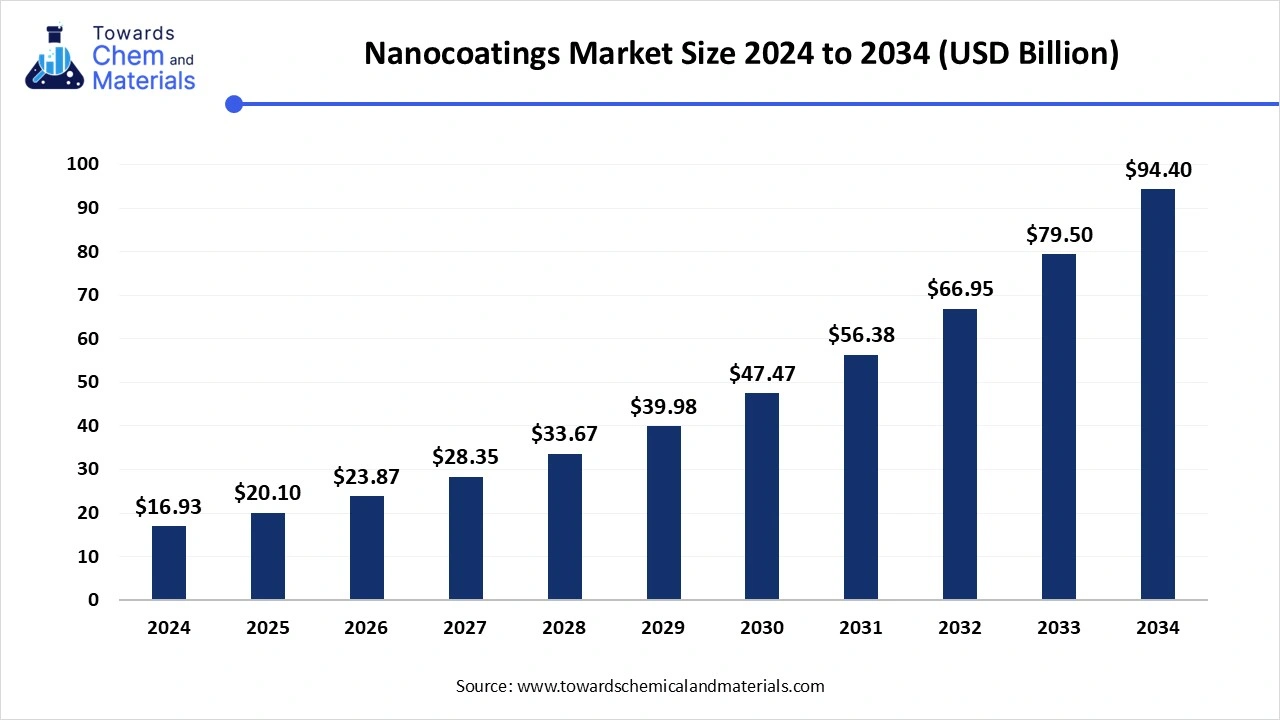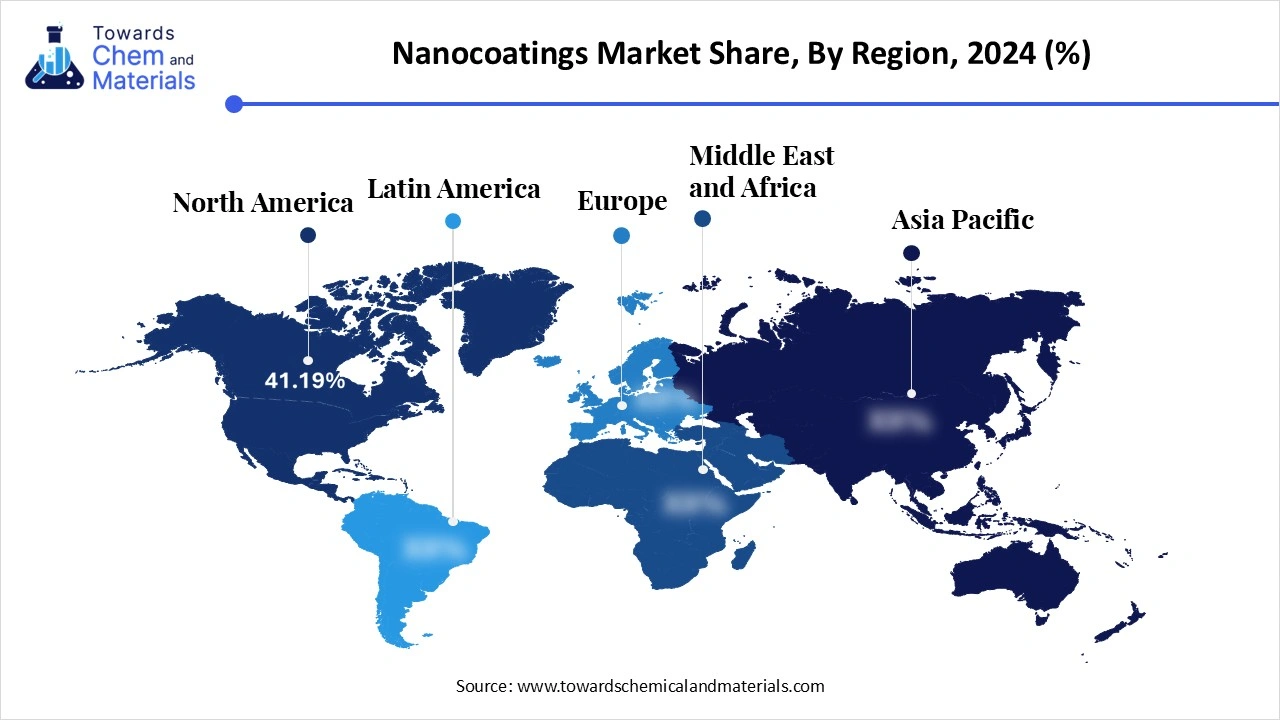April 2025
The global nanocoatings market size accounted for USD 16.93 billion in 2024 and is predicted to increase from USD 20.10 billion in 2025 to approximately USD 94.40 billion by 2034, expanding at a CAGR of 18.75% from 2025 to 2034. the rising demand for nano-coatings from various industries like automotive, electronics, construction, healthcare, and food & packaging drives the growth of the market.

Nano-coating is a protective coating that consists of an ultra-thin layer of materials applied to the surface to enhance qualities like durability, water-repellent, and scratch-repellent. It protects surfaces from dust, damage, dirt, and corrosion. These coatings are used in various industries like automotive, healthcare, packaging, construction, and textile to enhance product qualities. There are various types of nano-coating available, such as anti-corrosion, waterproof, antibacterial, thermal barrier, anti-fingerprint, and many more. The rising demand for high-performance coating is responsible for the growth of the market. Continuous technological advancement in nanotechnology and industries' preference for sustainability are key factors for the growth of the nano-coatings market. Nano-coating revolutionizing the construction sector.
The growing demand of construction uses nano-coating to improve durability, sustainability, and performance of construction materials. They build a protective layer on construction materials such as concrete, steel, and glass and extend the lifespan of the material. It consists of features like dirt resistance, water resistance, corrosion resistance, and pollution resistance. It helps to improve the insulation and energy efficiency of materials. In concrete, cement nano-coating helps to improve the durability and resistance of the material. It protects steel and metal from corrosion.
Nano-coating reduces the need for cleaning by providing self-cleaning and water-repellent surfaces on windows and glass. It is useful in various construction materials such as wood, brick, and plastic and drives market growth. Rising environmental concerns and preference for sustainability help in market growth. All these factors are responsible for reducing maintenance costs, which raises demand for nano-coatings in the construction and building sector.
| Report Metric | Details |
| Market Size in 2025 | USD 20.10 billion |
| Expected market size in 2034 | USD 94.40 billion |
| Growth rate | CAGR of 18.75% from 2025 to 2034 |
| Base year | 2024 |
| Forecast period | 2025-2034 |
| Dominant region | North America |
| Segment covered | Product, substrate,coating methods,raw materials,application,region |
| Key companies profiled | Tesla NanoCoatings, Inc.; Nanovere Technologies, LLC.; P2i Ltd.; PPG Industries, Inc.; Nano Gate; Nanophase Technologies Corporation.; actnano; Forge Nano Inc.; Nanofilm. |
Nano-coatings are widely used in the healthcare sector due to their improved biocompatibility, antimicrobial capabilities, and technological advancements in medical devices. It helps to prevent microbial growth, bacterial growth, and biofilm formation on medical devices due to this infection risks reduces. It helps improve the durability and resistance of medical devices. Materials made using nano-coating don’t cause any harm to the body due to their biocompatibility. They can be used in diagnostic tools and imaging agents. In healthcare, nano-coating is used in medical implants like stents, catheters, and prosthetic devices to reduce the risk of infections. Companies like 3M Healthcare, Bio-Gate AG, Smith & Nephew plc, and many more support the growth of the market in the sector.
Despite the several benefits of nano-coating, the complex manufacturing process is restricting the growth of the market. Manufacturing nano-coating materials requires intricate processes, specialized equipment, and expertise in technology. These materials are made up of thin coatings that require techniques like physical vapor deposition, chemical vapor deposition, and electroplating. These properties enhance the hydrophobicity and corrosion resistance of materials. Some nano-coating processes are sensitive to conditions such as temperature and air quality, which hampers the manufacturing process. This complex process creates problems in maintaining the quality of coating which results in the limitation in the nano-coatings market expansion.
North America dominated the nano-coating market in 2024. Rising demand from industries like healthcare, automotive, electronics, and construction helps in the growth of the market. A well-developed technological infrastructure and significant investment in research and development fuel market growth in the region. A strong demand for environment-friendly and sustainable choices increases demands for nano-coatings. The presence of key manufacturers in the region helps in the growth of the market. Strong government subsidies, policies, and interest rates increased the adoption of nano-coatings. The growing utilization of premium vehicles in the region drives the growth of the market.
The United States dominates the nano-coating market. A well-developed technological infrastructure and strong investment in research and development drive the market growth. In the United States, automotive, electronics, aerospace, and construction are key users of nano-coating material. Rising preference for sustainability and awareness about environmental concerns demand eco-friendly nano-coatings material. The United States consists of key manufacturers of nano-coating material that further fuels market growth.

Asia-Pacific expecting the fastest growth in the nano-coatings market during the forecast period. The growing civilization and industrialization in the region drive the growth of the market. Countries like China, India, and Japan demand advanced coating materials, which fuels the market growth. The automotive and electronics sector experiences growth in the region, driving demand for nanocoating material. The construction industry is booming in the region, which raises demands for decorative and protective coating. The government is investing in infrastructure development, and growing innovations are driving the growth of the market. Additionally, rapid economic growth and rising disposable income in the region propel the market growth.
China experiences rapid growth in the nano-coating market.The growing automotive industry and increased government support are fueling the market growth. Rising demand from various industries like construction, electronics, and healthcare drives the market growth. The rising industrialization and civilization demanded advanced materials that supported the market growth.
The anti-microbial segment dominated the nano-coatings market in 2024. The rising demand for long-term protection against microbial contamination and pathogens to prevent infections drives the growth of the market. Rising awareness about hygiene and cleanliness in industries like healthcare and food packaging fuels the market growth. It protects the surface from microbial growth and maintains hygiene. The increasing demand from the textile industry to avoid bacterial growth and prevent odour propels the market growth.
The anti-fingerprint segment expects the fastest growth in the nano-coatings market during the forecast period. Increasing demand for anti-smudging and anti-adhesive properties from industries like automotive and electronics drives the growth of the market. This coating provides a clean & sleek appearance. These types of coatings are important for touch-based technology to maintain cleanliness, and they reduce maintenance costs. Sectors like stainless steel, consumer goods, automotive, building, and construction increase demand for anti-fingerprint coatings and drive market growth.
The medical & healthcare segment dominated the nano-coatings market in 2024. The growing awareness about hygiene fuels the market growth. Rising demand from the medical industry to improve the durability and biocompatibility of medical devices and equipment drives the market growth. To reduce the growth of microorganisms and infection, the healthcare industry requires nano-coatings. These coatings enhance lifespan and protect medical devices from corrosion & damage. In the healthcare industry, medical devices, surgical tools, diagnostic equipment, and therapeutic devices use nano-coating materials and drive market growth.
The energy application segment expects a significant growth in the nano-coatings market during the forecast period. The growing consumer demand for renewable energy sources helps in the market growth. In solar energy, by reducing light reflection and enhancing light absorption, nano-coating increases the efficiency of solar panels. It used to manufacture advanced batteries. Rising energy production and minimized energy consumption drive the market growth. Stringent environmental policies and innovations in technology foster the growth of the market.

April 2025
April 2025
April 2025
April 2025